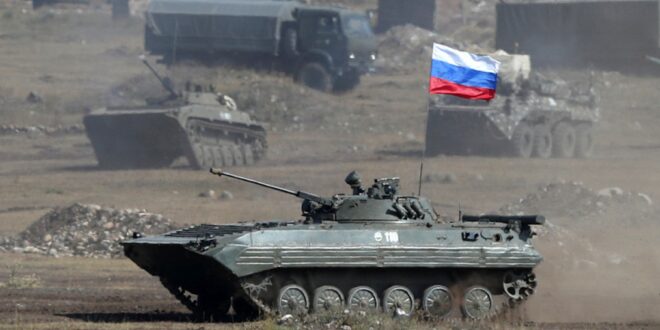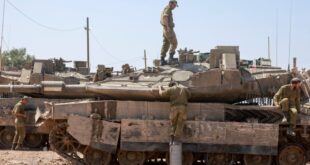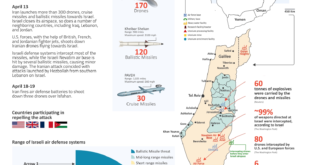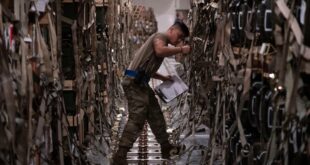The report “NATO-2030,” presented in early December in Brussels, recognizes Russia as the main threat to the coming decade. The Alliance is moving on to a deterrent strategy for the Cold War. Military columnist Alexander Goltz believes that the unity of the West is especially clear against the background of the CSTO created by Russia, where every participant is ritually bows to Putin, but he is not ready for a confrontation with the Kremlin’s opponents.
Wars are not announced today. Their beginning is marked by missile launches, air and artillery strikes. But the beginning of the Cold War is marked by lengthy declarations (remember even the Fulton speech of Winston Churchill). In Russia, they tried to pay not too much attention to the recently presented in Brussels report “NATO” – 2030. Unity in the new era. The official representative of the Foreign Ministry in two blatant paragraphs stressed only the miscons of NATO experts who do not want to notice Moscow’s desire for cooperation and justify the Russophobia of Brussels. As the Russian foreign policy officials are found, from the words of Maria Zakharova it follows that this Russophobia swept the NATOs from no means, for no apparent reason. As if there was no annexation of Crimea or “secret” war in Donbass
Meanwhile, this report is more than a reason for the angry pylippic Zakharov. A year ago, during the summit in London, the heads of NATO member states instructed Secretary General Jens Stoltenberg to begin an analysis of the prospects for the Alliance. At the end of March 2020, he created a group of several well-known experts, headed by former German Defense Minister Thomas de Maiziere and Wess Mitchell, former US Undersecretary of State. And in early December, during the meeting of the foreign ministers of the Alliance, a presentation of the report prepared by the experts was held. The speech of the NATO Secretary General left no doubt that he was quite in solidarity with the conclusions. And, in not so distant times, his theses will be the basis for NATO’s policy documents. The report, which is characteristic of such documents, covers the widest range of problems: here the future threat that China can pose, and the ongoing war on terrorism, and control over breakthrough technologies, and respect for civil rights.
For us, the main thing is this document, fixes the fundamentally changed attitude towards Russia. The report indicates that the 2010 and current NATO Strategic Concept clearly does not respond to the changed situation in the world. One of its main goals was to establish a strategic partnership with Moscow. After the events of 2014, it looks like a strange anachronism. Experts state:
Russia's aggression against Georgia and Ukraine, accompanied by the continued build-up of its military power and aggressive activity in the Baltic and Black Sea regions, the Eastern Mediterranean, the Baltic and the Far North, has led to a sharp deterioration of relations and negatively affected the security of the Euro-Atlantic region.I must say that such a description is characteristic of NATO policy documents that have been adopted for the past six years. Such passages can easily be found in the final documents of the summits in Wales, Warsaw, Brussels and London. However, the report represents a new step. For the first time, he points to Russia as the main source of the military threat for the next decade. Our country is unconditionally given the first place in the list of threats.
The report for the first time points to Russia as the main source of military threat for the next decadeFor quite a long time, Western politicians and experts have avoided comparing the current confrontation with Russia with the previous Cold War. It’s not just that today’s military confrontation is very different from what divided the world in the 1940s and 1980s. At the same time, they pointed to the absence of the notorious struggle of two systems, two ideologies. And Russia’s capabilities are now much more modest than the USSR had. Not a large economy, a rather weak industry, obviously incapable of mass arms. Plus the elderly population, from which it is no longer possible to form five million armed forces. In addition to these objective factors, subjective political calculations also played a role. The collapse of the USSR in NATO was seen as a victory. Therefore, the leaders of the North Atlantic Alliance strongly did not want to recognize the reality, namely that Russia, becoming now a full-fledged successor of the Soviet Union, resumed a military confrontation with the West. Only now, considering the prospects for the development of NATO, experts made an inevitable conclusion.
The authors of the report try not to use the phrase “cold war” but in the document a large number of direct references to this concept:
In some ways, NATO's political role is more reminiscent of the period until 1989, when it was a stronghold of democracy against an authoritarian adversary. They insist on the need to build relations with Russia, based on two approaches. The first is a full-blown deterrence characteristic of the previous Cold War: NATO must maintain an adequate capacity of conventional and nuclear weapons, and have the ability to resist aggression throughout the alliance.At the same time, the second approach is a dialogue with Russia. But the dialogue is quite specific: ?NATO must remain open to discuss peaceful coexistence and respond positively to constructive changes in Russia’s position. However, in order to be productive, such dialogue must be firm and be conducted from a standpoint of unity and strength. The implementation of Russia’s obligations under international law and bilateral agreements, including the waiver of the use of force. Without bruising, the authors of the report demand that NATO states adhere to a unified position towards Russia. The report, which will form the basis for the future Strategic Concept of the Alliance, leaves no doubt: NATO enters a period of long confrontation with Russia. It is not necessary to expect that the relationship will return to the norm. The document directly states that such a return is possible only if Russia again adheres to international law. This obviously means the return of the previously captured territory, which is impossible under the existing authorities in principle. The cold war in our eyes is becoming a reality. And Russia’s position in it is quite weak.
The authors of the report “NATO” – honestly point to the internal problems of the North Atlantic Alliance. In the future, they believe, it is necessary to avoid friction between the United States and its European allies (as we know, the escapades of the outgoing president have caused considerable damage to transatlantic relations). The document also calls for the exclusion of situations where the disagreement of only one country blocks the adoption of critical decisions. But the intra-NATO conflicts seem almost perfect unity, if we compare the position in the alliance with what is happening in the collective security Treaty Organization (CSTO) created by Russia’s will. The longer this union exists, the more obvious it becomes that its only meaning is to plead with the inferiority complex of the Kremlin’s superiors.
The only meaning of the CSTO is to pleic with the complex of inferiority of the Kremlin chiefsJust on the very day that the report “NATO-2030” was presented in Brussels, Vladimir Putin held a video conference with the leaders of the CSTO member states. The whole meeting was held according to the laws of Chekhov’s drama – in the appearance of dialogue, everyone spoke about his own. The Prime Minister of Armenia – that “Azerbaijan,” supported by Turkey and mercenary terrorists from the Middle East, unleashed a war against the Armenian people. The inabilityy head of Tajikistan Emomali Rahmon was expected to remind about the alarming development of the situation in Afghanistan. Surprisingly, the leaders of Kyrgyzstan, who have just experienced another political upheaval, and it seems that Kazakhstan has concentrated on the upcoming elections in each of the countries. And only the Belarusian president tried to explain by NATO’s intervention the fact that he is not willing to tolerate the residents of Belarus. It is clear that each country has its own security threats. Their leaders are ready to beat Putin ritual bows. But that’s all. They are not going to support him in confrontation with the West.
CSTO leaders are ready to beat Putin ritual bows, but are not going to support him in confrontation with the WestThe apparent supremacy of NATO in the new confrontation makes this confrontation only more risky. The weaker side is more prone to adventure. It is no coincidence that Vladimir Putin almost daily scares Western partners with Russian miracle weapons. The troops of Russia and NATO are in close proximity to each other. Their planes regularly fly to interception, and the ships threaten each other with a collision. More recently, the Russian BPC threatened to ram an American destroyer in the Gulf of Peter the Great. But on board the American ship – five dozen cruise missiles “Tomahawk.” Any incident threatens to cause irreversible catastrophic consequences.
Foreign Ministry representative Maria Zakharov was particularly outraged by the fact that the best option for relations with Russia, NATO believes not full-scale cooperation, but only peaceful coexistence. It is the only positive experience of the past Cold War. It is peaceful co-existence, which includes the rules of conduct of states with just opposite values, that effectively saved the planet from a nuclear catastrophe.
The Institute of the United States and Canada and the Institute of Europe have just published a notable study: “Dialogue “Russia” – NATO. How to reduce tensions and avoid crises. It was worked on four dozen well-known experts, former high-ranking politicians, diplomats and the military from the United States, Russia and other European countries. In fact, we are talking about a wide range of new mutual confidence measures that should reduce the threat of war. In particular, it is proposed to create special emergency channels of Russia-NATO in sensitive regions – the Baltic and Black Sea regions – as well as in the region of the Far North, to develop a set of unified joint rules that would determine the minimum distances when rapprochement of aircraft and ships, as well as the procedure for the interaction of crews. In addition, according to the authors of the recommendations, NATO and Russia should agree to refrain from the permanent deployment of additional significant combat forces in areas that are located near the territory of the other side in Europe.
We are also talking about the modernization of the Vienna document – the last agreement, which still somehow regulates military activity on the European continent. In particular, on military activity in the Baltic region (Estonia, Latvia, Lithuania, Belarus, Poland and Germany), the Kaliningrad and the Western military district of Russia could agree on special restrictions. Russia and NATO could agree to conduct major military exercises at a significant from the military point of view distance from the common borders, taking into account the specifics of certain areas of contact. As for the sudden exercises, which remain a source of tension and do not fall under preliminary notifications (in 2014, Moscow, under the guise of such maneuvers, conducted a concentration of troops at the border in Ukraine), a tidy notification should be carried out, so that information about such exercises is confidentially transmitted at a high level to the other side, remaining a surprise to the troops themselves.
Obviously, it is very important now to accept a new Cold War as a fait accompli and think about how to reduce the risks of a military clash.
 Eurasia Press & News
Eurasia Press & News




